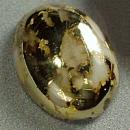|
|
|
|
Click on a letter above to view the list of gems. |
|
|
|
|
|
Gold
(Native) |
|
| Chemistry: Au [Elemental Gold] | |
| Discovered
in Prehistory;
IMA
status: Valid (pre-IMA; Grandfathered). | ||
|
| ||
|
Classification |
|
|
| |
|
Elements | |
|
1/A.01-10 | |
|
|
1 : ELEMENTS (Metals and intermetallic alloys; metalloids and
nonmetals; carbides, silicides, nitrides, phosphides) |
|
Related to: |
Copper Group. Gold - Silver Series. Gold - Palladium Series. |
|
|
|
|
Crystal Data |
|
|
|
|
|
As octahedra, dodecahedra, and cubes, typically crude or rounded, to about 5 cm. In twinned and parallel crystal groups; reticulated, dendritic, arborescent, platy, filiform, spongy; massive, and in rounded nuggets; scales and flakes. |
|
|
Common on [111]; repeated to form reticulated and dendritic aggregates. |
|
|
|
|
|
Physical Properties |
|
|
|
|
|
None Observed |
|
|
Hackly, Jagged |
|
|
Highly Malleable and Ductile |
|
|
2.5 - 3.0 |
|
|
19.30 (g/cm3) |
|
|
None |
|
|
Not Radioactive |
|
|
Other: |
Highly Conductive |
|
|
|
|
Optical Properties |
|
|
|
|
|
Yellow, pale Yellow, Orange, Yellow White, Reddish White |
|
|
Opaque |
|
|
Metallic |
|
|
R: (400) 36.8, (420) 36.8, (440) 36.4, (460) 36.1, (480) 36.7, (500) 45.3, (520) 62.5, (540) 75.0, (560) 82.2, (580) 86.8, (600) 89.7, (620) 91.9, (640) 93.3, (660) 94.1, (680) 94.8, (700) 95.3 |
|
|
0.00 (Opaque) |
|
|
None |
|
|
|
|
|
Occurances |
|
|
|
|
|
Geological Setting: |
Widespread in very small q\uantities in rocks of many kinds throughout the world, and in sea water. In veins of epithermal origin, typically in quartz with pyrite and other sulfides, and with tellurides; in pegmatites; in contact metamorphic deposits. Common in placers. |
|
Common Associations: |
Altaite, Ankerite, Arsenopyrite, Calaverite, Chalcopyrite, Krennerite, Pyrite, Pyrrhotite, Quartz, Scheelite, Sylvanite, Tetradymite, Tourmaline, |
|
Common Impurities: |
Ag, Cu, Pd |
|
Type Locality: |
Prehistic |
|
Year Discovered: |
Prehistic |
|
View mineral photos: | |
|
|
|
|
More Information |
|
|
|
|
|
| |
|
|
|
|
There
are many localities worldwide for fine gold specimens
for mineral collectors and native Gold cabochons. |
|
|
We
have not photographed our Gold gems. Please
check back soon. |
